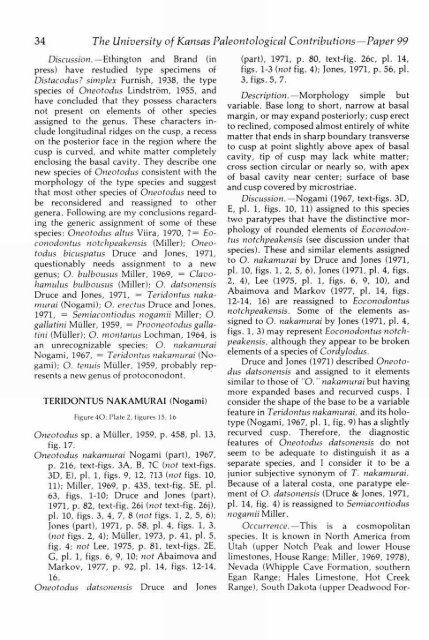View - KU ScholarWorks - University of Kansas
View - KU ScholarWorks - University of Kansas
View - KU ScholarWorks - University of Kansas
Create successful ePaper yourself
Turn your PDF publications into a flip-book with our unique Google optimized e-Paper software.
34 The <strong>University</strong> <strong>of</strong> <strong>Kansas</strong> Paleontological Contributions-Paper 99<br />
Discussion. -Ethington and Brand (in<br />
press) have restudied type specimens <strong>of</strong><br />
Distacodus? simplex Furnish, 1938, the type<br />
species <strong>of</strong> Oneotodus LindstrOm, 1955, and<br />
have concluded that they possess characters<br />
not present on elements <strong>of</strong> other species<br />
assigned to the genus. These characters include<br />
longitudinal ridges on the cusp, a recess<br />
on the posterior face in the region where the<br />
cusp is curved, and white matter completely<br />
enclosing the basal cavity. They describe one<br />
new species <strong>of</strong> Oneotodus consistent with the<br />
morphology <strong>of</strong> the type species and suggest<br />
that most other species <strong>of</strong> Oneotodus need to<br />
be reconsidered and reassigned to other<br />
genera. Following are my conclusions regarding<br />
the generic assignment <strong>of</strong> some <strong>of</strong> these<br />
species: Oneotodus altus Viira, 1970, 7= Eoconodontus<br />
notchpeakensis (Miller); Oneotodus<br />
bicuspatus Druce and Jones, 1971,<br />
questionably needs assignment to a new<br />
genus; O. bulbousus Miller, 1969, = Clavohamulus<br />
bulbousus (Miller); O. datsonensis<br />
Druce and Jones, 1971, = Tendon tus nakamurai<br />
(Nogami) ; O. erectus Druce and Jones,<br />
1971, = Semiacontiodus nogamii Miller; O.<br />
gallatini Muller, 1959, = Prooneotodus gallatini<br />
(Muller); O. montanus Lochman, 1964, is<br />
an unrecognizable species; O. nakarnurai<br />
Nogami, 1967, = Teridontus nakamurai (Nogarni);<br />
O. tenuis ller, 1959, probably represents<br />
a new genus <strong>of</strong> protoconodont.<br />
TERIDONTUS NAKAMURAI (Nogami)<br />
Figure 40; Plate 2, figures 15, 16<br />
Oneotodus sp. a Muller, 1959, p. 458, pl. 13,<br />
fig. 17.<br />
Oneotodus nakamurai Nogami (part), 1967,<br />
p. 216, text-figs. 3A, B, 7C (not text-figs.<br />
3D, E), pl. 1, figs. 9, 12, 713 (not figs. 10,<br />
11); Miller, 1969, p. 435, text-fig. 5E, pl.<br />
63, figs. 1-10; Druce and Jones (part),<br />
1971, p. 82, text-fig. 26i (not text-fig. 26j),<br />
pl. 10, figs. 3, 4, 7, 8 (not figs. 1, 2, 5, 6);<br />
Jones (part), 1971, p. 58, pl. 4, figs. 1, 3,<br />
(not figs. 2, 4); Muller, 1973, p. 41, pl. 5,<br />
fig. 4; not Lee, 1975, p. 81, text-figs. 2E,<br />
G, pl. 1, figs. 6, 9, 10; not Abaimova and<br />
Markov, 1977, p. 92, pl. 14, figs. 12-14,<br />
16.<br />
Oneotodus datsonensis Druce and Jones<br />
(part), 1971, p. 80, text-fig. 26c, pl. 14,<br />
figs. 1-3 (not fig. 4); Jones, 1971, p. 56, pl.<br />
3, figs. 5, 7.<br />
Description. -Morphology simple but<br />
variable. Base long to short, narrow at basal<br />
margin, or may expand posteriorly; cusp erect<br />
to reclined, composed almost entirely <strong>of</strong> white<br />
matter that ends in sharp boundary transverse<br />
to cusp at point slightly above apex <strong>of</strong> basal<br />
cavity, tip <strong>of</strong> cusp may lack white matter;<br />
cross section circular or nearly so, with apex<br />
<strong>of</strong> basal cavity near center; surface <strong>of</strong> base<br />
and cusp covered by microstriae.<br />
Discussion. -Nogami (1967, text-figs. 3D,<br />
E, pl. 1, figs. 10, 11) assigned to this species<br />
two paratypes that have the distinctive morphology<br />
<strong>of</strong> rounded elements <strong>of</strong> Eoconodontus<br />
notch peakensis (see discussion under that<br />
species). These and similar elements assigned<br />
to O. nakamurai by Druce and Jones (1971,<br />
pl. 10, figs. 1, 2, 5, 6), Jones (1971, pl. 4, figs.<br />
2, 4), Lee (1975, pl. 1, figs. 6, 9, 10), and<br />
Abaimova and Markov (1977, pl. 14, figs.<br />
12-14, 16) are reassigned to Eoconodontus<br />
notchpeakensis. Some <strong>of</strong> the elements assigned<br />
to O. nakamurai by Jones (1971, pl. 4,<br />
figs. 1, 3) may represent Eoconodon tus notchpeakensis,<br />
although they appear to be broken<br />
elements <strong>of</strong> a species <strong>of</strong> Cordylodus.<br />
Druce and Jones (1971) described Oneotodus<br />
datsonensis and assigned to it elements<br />
similar to those <strong>of</strong> -O. nakamurai but having<br />
more expanded bases and recurved cusps. I<br />
consider the shape <strong>of</strong> the base to be a variable<br />
feature in Teridontus nakamurai, and its holotype<br />
(Nogami, 1967, pl. 1, fig. 9) has a slightly<br />
recurved cusp. Therefore, the diagnostic<br />
features <strong>of</strong> Oneotodus datsonensis do not<br />
seem to be adequate to distinguish it as a<br />
separate species, and I consider it to be a<br />
junior subjective synonym <strong>of</strong> T. nakamurai.<br />
Because <strong>of</strong> a lateral costa, one paratype element<br />
<strong>of</strong> O. datsonensis (Druce & Jones, 1971,<br />
pl. 14, fig. 4) is reassigned to Semiacontiodus<br />
nogamii Miller.<br />
Occurrence. -This is a cosmopolitan<br />
species. It is known in North America from<br />
Utah (upper Notch Peak and lower House<br />
limestones, House Range; Miller, 1969, 1978),<br />
Nevada (Whipple Cave Formation, southern<br />
Egan Range; Hales Limestone, Hot Creek<br />
Range), South Dakota (upper Deadwood For-
















